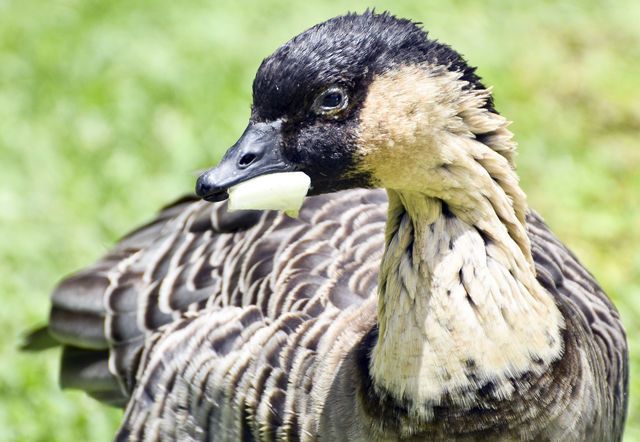Decades of conservation efforts to help the nene population rebound are paying off as scientists begin to understand more about the endangered bird’s ecology and life history. “They’re a really unique story,” said Steven Hess, a wildlife biologist at the
Decades of conservation efforts to help the nene population rebound are paying off as scientists begin to understand more about the endangered bird’s ecology and life history.
“They’re a really unique story,” said Steven Hess, a wildlife biologist at the U.S. Geological Survey who has tracked nene migration patterns using satellite transmitters for the past several years. “Most people look at them and (just) see a goose.”
That story has its roots on the Big Island, where an intercontinental effort to save the species from extinction was launched in 1950. At the time, the entire nene population was no more than 50 birds, with some estimates as low as 20 individuals.
Today, the numbers are up to 2,500 statewide — thanks in part to recovery efforts on Kauai
“It’s always rewarding to know that our management section on the ground can actually (help),” said Kim Uyehara, biologist for the Kauai National Wildlife Complex through the U.S. Fish and Wildlife Service. “It’s actually nice to know they’ll respond to that management and are recoverable.”
Kilauea Point boasts the largest breeding site in the state with between 120 to 160 breeding pairs. But populations haven’t always been so flush.
Habitat loss and introduction of predators such as rats and dogs had already taken a toll on the nene population by the time Europeans arrived. Before mammals were introduced to Hawaii, the goose’s main predators were hawks and owls.
Overhunting combined with the arrival of more rats, mongoose and cats caused numbers to fall further. Half of the already shrunken flock was wiped out during the 1946 tsunami.
In 1950, Herbert Shipman sent three Big Island nene to the Wildfowl and Wetlands Trust in Great Britain to start incubating the recovery.
He at first sent two, but both turned out to be female. Kamehameha IV, Queen Emma, and Queen Kapiolani went on to raise 103 goslings, jump-starting a new breeding population.
Today, they have been successfully reintroduced to Kauai — an effort so successful that now Kauai geese are being moved back to the Big Island and Maui. Last year, a breeding pair took up residence on Oahu.
Still, it’s not a without bumps.
On Kauai, breeding season means motorists should be on the lookout, Uyehara said.
Many nene are flightless from October through March, and attracted to roadsides where runoff and streetside mowing provide easy access to food and water for the land-bound birds.
Last season around a dozen were struck, and several killed, including Black XL, named for the band she wore on her ankle, and one of 24 endangered birds released on the Garden Isle 15 years ago during that initial recovery push.
“We’re trying to be less reactionary this year,” Uyehara said about getting word out early and posting signs for people to be aware of the situation. “We’re looking into different signs, outreach, communications, it’s also a busy season for cars with the number of tourists that time of year.”
Some experts said it’s difficult to grasp that the numbers even got that low.
“It’s hard to imagine just so few, getting down to that level,” said Jack Jeffrey, former wildlife biologist at Hakalau Forest Reserve.
Jeffrey retired in 2008. One of his projects in the 1990s was moving a flock of birds into the reserve to keep them safe from predators.
Hakalau was an ideal location for a nene release because of the open pasture in its upper parts — and because it’s fenced off.
“They like golf courses and pasture and things like that because they’re grazers,” Jeffrey said.
There are also populations at Hawaii Volcanoes National Park.
On the western side of the island, nene have taken up residence at the Big Island Country Club. Superintendent Steve Worley said they tend to hang out near the water holes.
Golfers “pretty much learn to respect them, and that’s the great part,” Worley said.
Though there is still one pair lingering at the course, the geese are only there seasonally — to breed and start raising goslings.
“At the start of football season, the flocks start coming over,” Worley said.
Then they move on — that’s where Hess’ satellite tracking comes in. His research, conducted with fellow USGS researcher Christina Leopold, began in 2008, when almost nothing was known about the birds’ migration paths. The nene would show up at different sites across the island depending on the season, but what they were doing en route, and what those routes were, remained a mystery.
“We know a lot about where they go now, and we know a lot about the habitat they use,” Hess said.
When goslings are old enough to fly, the Hakalau and country club geese leave their respective home bases and meet up at Kipuka Ainahou off Saddle Road. The entire flock then travels south to Kahuku.
“There’s a big social component in their life,” Hess said.
The birds form lifelong pair bonds and raise their young together.
“The pairs always travel together, so we put (transmitters) on the males, and we know where the females are,” Hess said.
Nene migrations are altitudinal: They move from high to low elevations and back again.
It’s straightforward enough, but the pattern is one that the nene had to re-teach themselves over time, generation after generation.
“They don’t have an innate sense of where they’re migrating,” Hess said. “They learned it from their parents. This is something that’s taken decades for nene to recover.”
Since nene goslings need to learn life skills from their parents, raising them in captivity and releasing them as adults, though well-intentioned, was often a fruitless endeavor.
“Birds that raise their own kids have a higher survival rate,” Jeffrey said.
Understanding the birds’ migration paths makes it easier to establish means of protecting nene flyways and habitats. The species is still vulnerable: There are predators to deal with, and for all of its new knowledge, the bird hasn’t learned to stay out of the way of cars.
“Geese are pretty slow in their walking,” Jeffrey said.
But for proof of how far the bird has come from the brink, Jeffrey just looks up. He lives in Pepeekeo, along a nene flight path.
“I see nene fly over, and that is really exciting,” he said. “Twenty years ago, no way would we have seen that.”
•••
The Associated Press contributed to this report.




